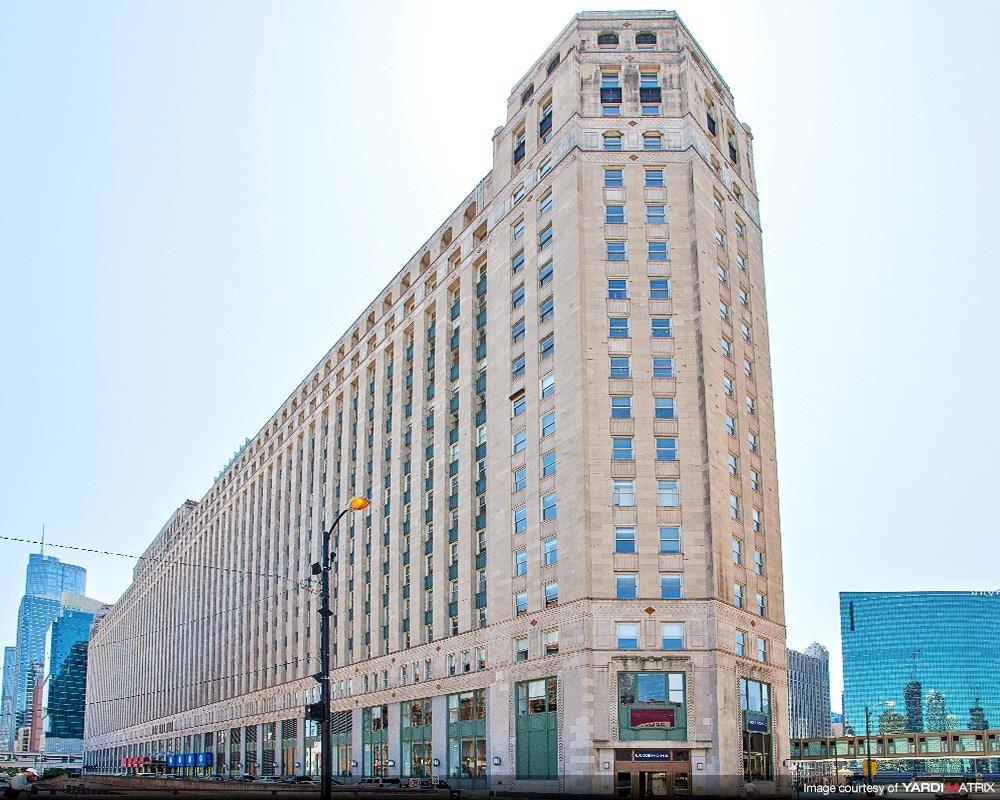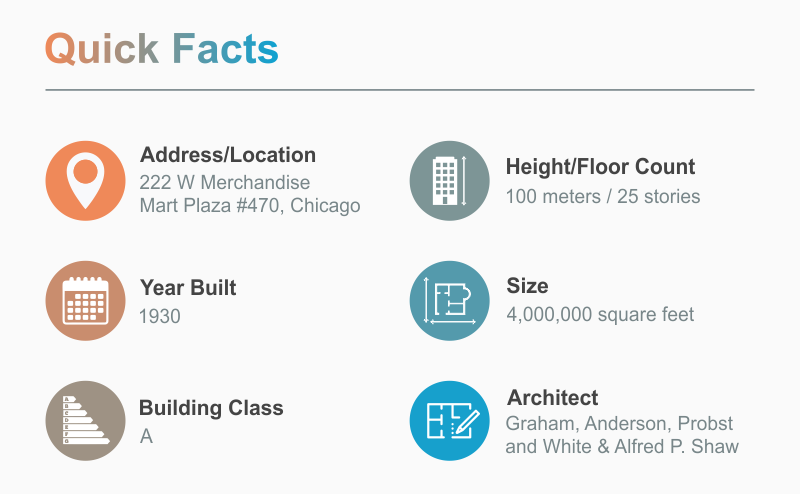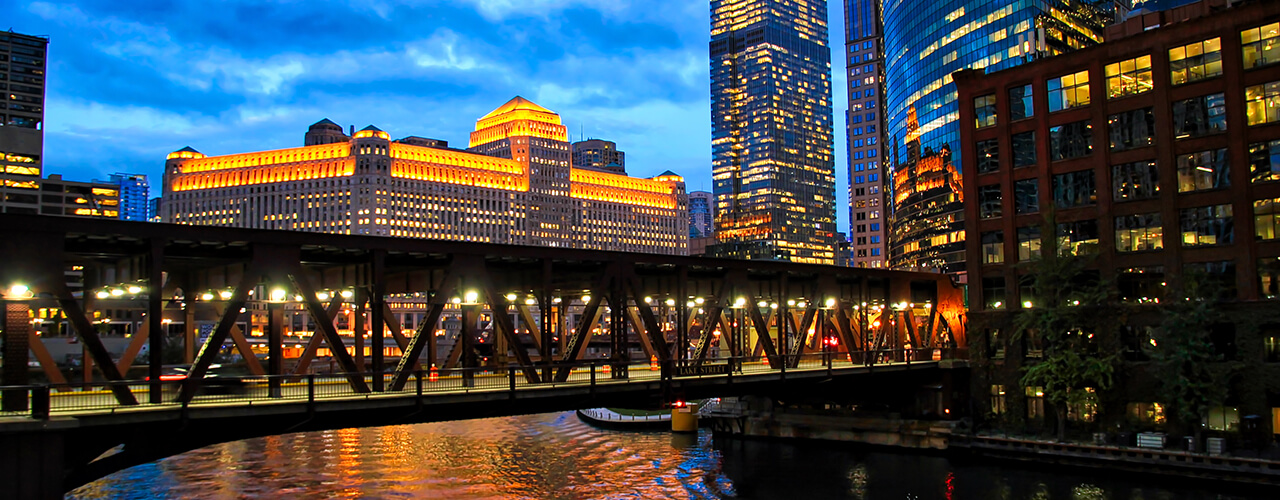

Located at the junction of the Chicago River’s two main branches, Merchandise Mart has been one of the most iconic buildings on the Windy City skyline since its construction was finalized in 1930. With over 4 million square feet of floor space spanning two city blocks and boasting 25 stories, it was the largest building in the world at the time of completion, and it still holds the title for the largest wholesale design center.
Construction and Development
Retail company Marshall Field & Co. revealed its construction plans on the north bank, opposite the popular Wacker Drive development, in 1927. The building would stand on historic land, namely the area’s first trading post, a place where Native Americans and trappers haggled and traded goods with each other. It was also the site of an abandoned train yard, which everyone was quite eager to get rid of in order to make the riverfront more appealing. The project was taken on by local architecture firm Graham, Anderson, Probst, and White, with Alfred P. Shaw serving as chief architect.
The construction process began on August 16, 1928, and it required enormous endeavor, modern equipment and a total of 5,700 workers to complete it one and a half years later. It is said that the methods and systems used could normally only be seen during the building of dams. Massive amounts of construction materials were used in the process, including 4 million cubic yards of concrete, 40 miles of plumbing, 380 miles of wiring and 29 million bricks. The total cost of the development is said to have been around $26 million.
Completed on May 5, 1930, it was the largest building on the planet, a title it held until 1943 when the Pentagon was built. After this, the Merchandise Mart advertised itself as the largest commercial building in the world.
Since its completion, the building has undergone a series of maintenance and modernization efforts. In the late 1950s and 1960s, a few decorative elements were removed and an entrance canopy was issued. The Chicago Apparel Center was completed in 1977 and was merged together with the Merchandise Mart, expanding its size to a total of 6.2 million square feet. An additional $100 million modernization project in the 1980’s upgraded the public utility system, whilst a 1989 commission created additional entrances and modernized the lobby. In 2007, the Merchandise Mart received a LEED (Leadership in Energy and Environmental Design) Silver Certification.
Architecture and Artwork
The entire building is adorned by Art Deco elements, incorporated by the head designer, Alfred Shaw, with the style of warehouses, department stores and skyscrapers in mind. The symmetric façade has a 25-story tower at its center and boasts a skyscraper-like peak at its top. The ribbon pier borders of the windows, the chamfered corners of the edifice and the corner pavilions were all included to visually reduce the bulky aspect of the building. The raised panels are embellished with the initials of the Merchandise Mart, a symbol that can be seen throughout the entire building, both inside and out.
Carvings of 56 American Indian chiefs circled around the tower crown, giving a nod to the history of the site. They were barely visible from street level and were meant to be admired from the future skyscrapers which would surround the Merchandise Mart. Since such edifices were never actually built, the chiefs were taken down in 1961 and were replaced by concrete plates.
Eight square marble piers define the lobby, while embossed bronzed trim decorating the storefronts was used in the side aisles. The building’s initials can be found also on the green and orange terrazzo floor, which boasts a mixed pattern of stripes and squares, aimed to resemble the appearance of a carpet.
In 1953 Joseph Kennedy authorized eight bronze busts to be put on display in front of the gold entryway by the riverfront. The statues are four times life-size, were made with the aim of “immortalizing the outstanding merchants” of the nation, and the area is referred to as the Merchandise Mart Hall of Fame.
Artwork can also be found in the lobby area, where a frieze of 17 murals—a masterpiece by Jules Guerin—is on display. The artist portrayed significant industries, products, modes of transportation and the architecture of 14 different countries, with a unique technique combining red with gold leaf.
Operations and Usage
Upon its completion, the Merchandise Mart served as a wholesale center and was home to 13 different warehouses. Since the building was finished right in the midst of the Great Depression, it soon faced financial crises, so the owners reduced the space to less than half its size. They managed to keep themselves afloat by leasing some of the available space to the federal government.
Joseph P. Kennedy bought the Merchandise Mart in 1945 for roughly half the price it cost to build. He gradually reopened the majestic edifice to the public by converting the government offices back to showrooms and by hosting a variety of conventions, events and trade shows, which would regain the attention of retailers from across the nation. Wally Ollman and Sargeant Shriver were the new general managers, and they paved the way for Chicago to become a hub of the American tourism and convention industry.
NeoCon, the annual National Exposition of Contract Furnishings, has been held in the building since 1969 and is the largest trade show of its type in North America. Besides this, the Merchandise Mart has also been the home of several radio and television stations ever since it was first opened. NBC’s WENR and WMAQ stations resided there from its inception until 1989, with a staff of 300 that produced nearly 1,700 different programs each month. WMAQ’s former sister station WKQX still operates from the building.
On January 7, 1947, the first television program was broadcast from the Merchandise Mart, courtesy of NBC’s WNBQ station. On April 15, 1956, known today as C-day, NBC made a revolutionary move by making Channel 5 the first all-color television station in the world.
Merchandise Mart actually has its own train station, known as the ‘L’ Station, which was completed in December of 1930. It used to serve the Main Line of the North Side Division, but today it serves the Brown and Purple lines, connecting the edifice to Albany Park, Linden Avenue, and Downtown Chicago.
After over 50 years of ownership, the Merchandise Mart was sold by the Kennedy family to the Vornado Realty Trust in 1998, as part of a larger $625 million transaction. In 2007, it was estimated that the building was worth approximately $917 million.










